Are you thinking about visiting Yosemite National Park but aren’t sure what to expect when you want to go? Then this guide is for you.
I’m James and I’m a national park expert. In this guide, I’ll give you a detailed month-by-month breakdown of what the park has to offer during each season, so you can decide the best month to visit Yosemite National Park for your trip.
‼️ If you just want a quick snapshot about my thoughts on the best time to visit Yosemite National Park, check out my Best Time to Go to Yosemite National Park guide. ‼️
Subscribe to daily national parks planning tips, travel inspiration and trip ideas and get instant access to the free PDF of this guide to
Visiting Yosemite National Park Throughout The Year
No time right now to discover when is the best time to visit Yosemite National Park, California? Pin It and save it for later:

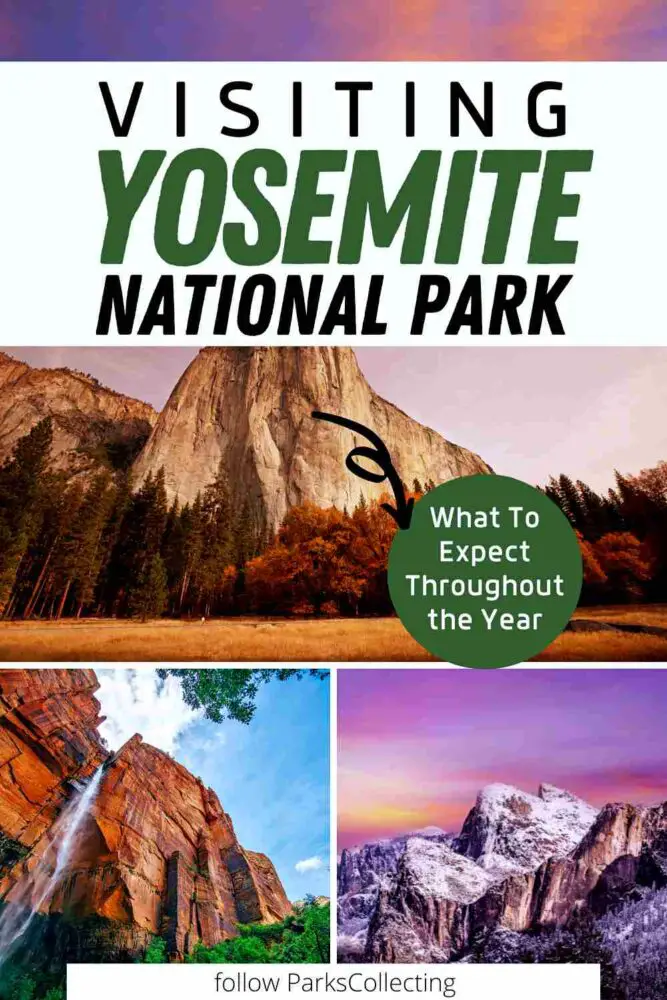
🛏️TOP HOTEL PICK: Check availability now
🚘FIND THE CHEAPEST CAR RENTAL: Search Discover Cars for the best deals
✈️FIND THE CHEAPEST FLIGHTS: Search Skyscanner for the best deals
🧳GET TRAVEL INSURANCE: Get insured with Travelex before you go
📱TAKE AN AUDIO TOUR: Buy an audio tour now
Table of Contents
Yosemite National Park in Spring (April – May)

So what can you expect at Yosemite Park in the season of spring? If you want to see Yosemite in spring, then April or May are the months to visit this national park. Spring in Yosemite brings some wet days and some warmer temperatures, and is the best time to see the park’s waterfalls.
Visiting Yosemite in April

So, what’s the Yosemite in April weather like, and what else can you expect when visiting during early spring? The Yosemite National Park weather in April is still a little wetter than average, with around six rainy days on average across the month.
The temperature in Yosemite National Park in April ranges between highs of about 64°F (18°C) and lows of around 37°F (3°C). So during the average April in Yosemite, you can expect even overnight temperatures to be milder than at any time since October.
Is April a good time to visit Yosemite National Park? Sometimes there may be some rain or even – rarely – snow at Yosemite in early April, but in general, things are warming up and the waterfalls are in full flow, following the rainfall and the melting of any winter snow.
When Easter falls in April, you can expect crowds around that time.
Pros
- Mild temperatures
- Drier than during winter
- Waterfalls may be in full flow
Cons
- Around 6 rainy days in April
- Snow is still possible, though not that likely
Visiting Yosemite in May
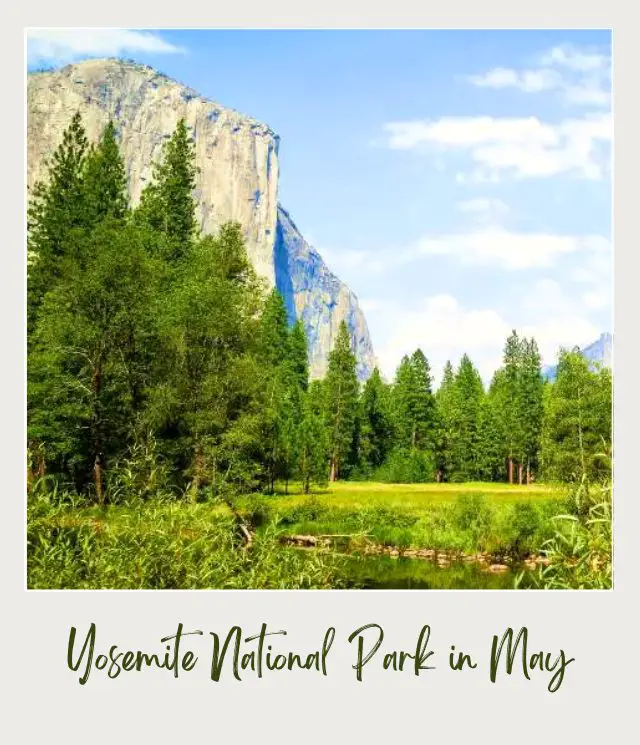
Visit Yosemite in May and you’ll benefit from the fact that the rain has mostly dried up and temperatures are climbing. The Yosemite temperature in May means that you can expect lows of around 43°F (6°C), with highs of about 73°F (23°C).
In terms of rainfall, the Yosemite weather in May sees around three wet days during the month. By this time you’ve reached the drier half of the year, so wet weather is less likely to impact on your visit. This is one of the best times to visit the park, with fewer crowds than in summer.
With cooler temperatures overnight and warm but not yet hot weather, the hiking conditions at Yosemite National Park in May are pretty much perfect. There may still be some mud on the trails, although the warm Yosemite National Park weather in May onwards should mean the ground soon starts drying out. Occasionally, though, some trails may still be shut at times during May.
Pros
- Drier half of the year
- Hiking conditions are ideal
- The weather is warm but not too hot
Cons
- The trails may still be muddy – or even closed
- It can still get cold overnight
Yosemite National Park in Summer (June – September)

The Yosemite summer brings hot, dry weather, particularly in July and August. Summer in Yosemite is a busy time, with crowds peaking during the school and college holidays. Of the summer period, the Yosemite weather in June and September is milder than during the hottest two months.
Visiting Yosemite in June

If you want to avoid the crowds, head to Yosemite in early June before the college students and school kids descend later in the summer. By the end of the month, the weather in Yosemite in June has heated up, and the park will also be much busier.
The Yosemite National Park weather in June brings low temperatures of about 50°F (10°C) and highs of around 82°F (28°C). This means it can get hot, but isn’t usually unpleasantly so. Hiking is generally comfortable, especially during the first part of the month.
The weather at Yosemite National Park in June is dry, with only a day of rain being average. As the weather has now been warmer for a while, the trails tend to be drier than in spring too.
Pros
- Warm but not yet too hot
- Only 1 day of rain on average
- It’s quieter during the first part of the month
Cons
- By late June it can get very busy
- Some days can be a little hot for hiking
Visiting Yosemite in July

As you might expect Yosemite around the 4th of July can be very crowded indeed. So what about the rest of the month, and how hot is the Yosemite National Park weather in July?
If you’re visiting Yosemite National Park in July, you can expect temperatures to range from 55°F (13°C) to 90°F (32°C). So it can get very hot in this part of California during July. If you want to hike, it might be best to set off during the early morning or later afternoon, rather than being out there when the sun is at its hottest.
Should you wish to visit Yosemite National Park in July, then booking travel and accommodations in advance is essential. This is peak season, with dry, sunny weather and lots of families and college students visiting.
In July, just one day of rainfall during the month is average.
Pros
- Lots of sunshine
- Only one day of rain on average
Cons
- It can get too hot for hiking
- The park can be very crowded
- You’ll need to book accommodations well in advance
Visiting Yosemite in August

If you are keen to head there during the peak summer season, then you’re going to want to know how the Yosemite National Park weather in August might affect your visit.
On average, the Yosemite temperature in August is comparable to July. You can expect highs of about 90°F (32°C), with lows of around 55°F (13°C). So the Yosemite weather in August means it’s pretty hot out there, especially during the late morning and early afternoon. Hikers are thus advised to set out as early as possible to avoid the midday heat – and associated conditions such as dehydration, sunstroke and sunburn.
Yosemite in August can get very busy indeed, before schools and colleges start up again for the new academic year. So again you’ll need to plan ahead when it comes to accommodation and travel when heading to Yosemite National Park in August.
The weather in Yosemite in August is at its driest, with no days of rain expected at all during the average August.
Pros
- Sunny weather
- Little to no rain throughout the month
Cons
- A very busy month for the park
- Midday temperatures can be uncomfortable
- Accommodations will need to be reserved well ahead of time
Visiting Yosemite in September

The Yosemite weather in September is a little cooler than during the two previous months. With the colleges and schools having started their new semesters, too, is September a good time to visit Yosemite?
Yosemite in September is certainly quieter than it is in July and August. As for the Yosemite National Park weather in September, you can expect average lows of 50°F (10°C), with highs hovering around 84°F (29°C). As you can see, the weather in Yosemite in September is very similar to that in June.
Yosemite National Park in September tends to be a lot more peaceful than during the preceding two months. With good weather and two days of rainfall, this is a great time to see the local wildlife, before some of the resident creatures enter winter hibernation.
Hiking conditions are also more comfortable than in July or August, though it can still get hot during the middle of the day. If you want to go to Yosemite and the best time to visit for you is in summer, then September can be a good choice.
Pros
- Milder weather than July and August
- Good time to see animals
- Fewer crowds
Cons
- Not ideal for families or college students
- The weather is starting to get wetter
Yosemite National Park in Fall (October – November)
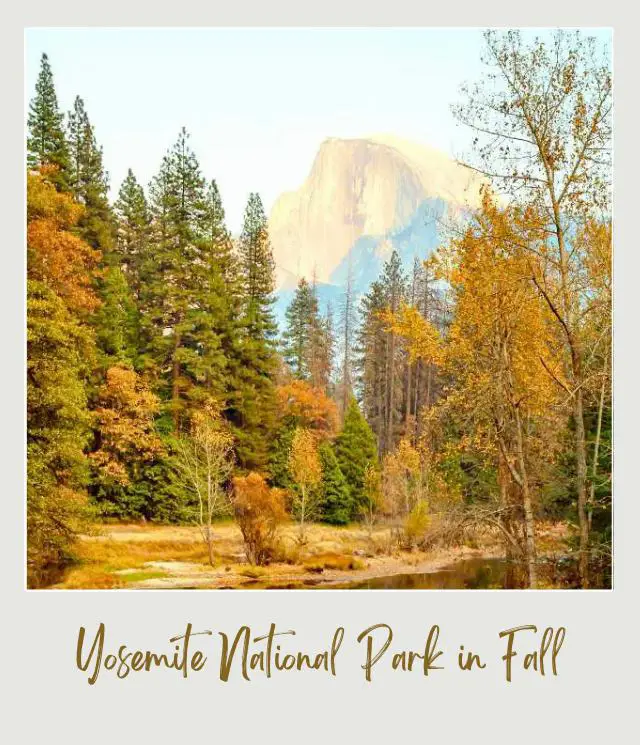
If you want to avoid the summer peak and cannot visit in September, then heading to Yosemite in fall might be an option. Fall in Yosemite occurs during October and November, and of course for Yosemite fall colors this is the best time to go.
Visiting Yosemite in October

The weather in Yosemite in October brings temperatures that begin to drop fairly sharply in comparison to summer highs. Visit Yosemite National Park in October rather than September, and you’re likely to know that it’s fall rather than late summer.
During October in Yosemite, the average Yosemite temperature in October ranges from lows of about 41°F (5°C) to highs of around 72°F (22°C). The Yosemite National Park October weather is very slightly wetter than in previous months, with three rainy days expected during the first month of fall.
One advantage of visiting at this time is that you can see the fall colors in all their glory. The Yosemite National Park weather in October is normally good for hikers, as it’s cooler than in summer but not yet too hot or wet.
Depending on when the Yosemite National Park temperature in October really begins to drop, you might get lucky with wildlife sightings at this time of year too.
Pros
- Cooler than in summer
- Good hiking conditions
- A peaceful time of year to visit
Cons
- Temperatures do drop at Yosemite in late October
- Some creatures may enter winter hibernation
- There may be several days of wet weather
Visiting Yosemite in November

If you’re wondering what the Yosemite National Park weather in November is like, then you should know that this is the first month after summer when temperatures can hit freezing. At Yosemite National Park in November, the weather also gets wetter, with about five days of rain expected during the month.
You can of course expect Yosemite National Park in late November to be colder and wetter, on average, than Yosemite in early November. So, if you want to hit the trails, earlier in the second month of fall is best. Around Thanksgiving can be busy, so do keep that in mind.
The Yosemite National Park temperature in November varies between highs of around 57°F (14°C) and lows of about 32°F (0°C). So, you’ll need extra layers, and to be prepared for cold overnight temperatures too.
Is November a good time to visit Yosemite National Park? The Yosemite weather in November generally involves crisp mornings, bright afternoons and cool evenings. You may even experience some snow during the month. So do be prepared for extreme Yosemite in November weather if you’ll be driving.
Pros
- Not as cold as in winter
- Crisp mornings and bright afternoons
Cons
- Chilly evenings
- Some chance of snow
- Five days of rain on average
Yosemite National Park in Winter (December – March)

If you’re planning on visiting Yosemite in winter, then it’s best to be prepared for rain or snow. Winter here runs from December to March, and is the coldest Yosemite season of all. This is a great time to travel on a budget, though, as lower demand sees prices dropping.
Visiting Yosemite in December
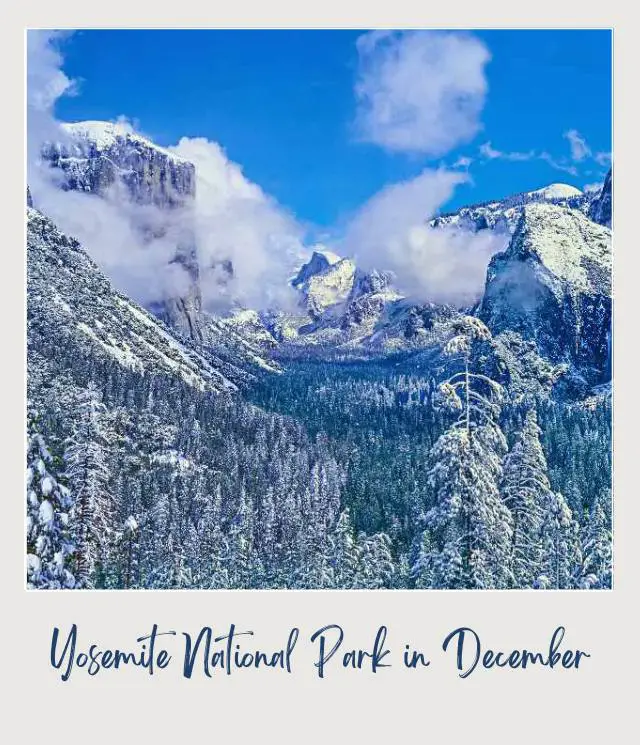
Yosemite National Park in December sees the coldest temperatures of the year, very closely followed by January. The temperatures at Yosemite during December range between 27°F (-3°C) and 48°F (°C).
So, is the Yosemite National Park December weather usually snowy? At Yosemite Park in December, low temperatures mean that you may get some snow – or the precipitation may fall as rain. It all depends on how cold it gets, as well as other weather conditions.
Along with January and February, the Yosemite National Park weather in December is about as wet as it gets. You can expect one week – or seven days – of rainfall per month. Be prepared for snowy roads and trails.
The plus side of visiting Yosemite in December is the peace and solitude. The snow-clad landscapes can also be incredibly beautiful. It can still sometimes get busy during the Christmas period, though.
Pros
- The snowy landscapes are very photogenic
- It’s very peaceful in the park
Cons
- Snow can cause issues on roads and trails
- This is the coldest month of the year
- Expect seven days of rain
Visiting Yosemite in January

The Yosemite National Park weather in January is very similar to that in December, on average. Once Christmas and New Year are over, though, Yosemite National Park in January can be even more peaceful than the preceding month.
January temperatures involve highs of about 48°F (9°C) and lows of around 28°F (-2°C). So do come prepared for cold weather, in terms of clothing, footwear and driving. You’re likely to need snow tires and chains at Yosemite in January.
If you don’t mind the cold, this can be a beautiful time to explore the park. Pack some warm and waterproof clothing and hiking boots, and of course, don’t forget your camera.
Pros
- The park is very peaceful
- The snow-clad landscapes are very pretty
Cons
- It can get very chilly in January
- Snow can cause trail and road closures
- Expect a week of rain spread over the month
Visiting Yosemite in February

At Yosemite National Park in February, the weather starts to warm up slightly in comparison to the earlier winter months. You can still expect sub-zero temperatures when measured in Celsius, however.
The Yosemite National Park weather in February involves highs of around 54°F (12°C) and lows of about 30°F (-1°C). As in December and January, you can still expect seven days of rain, so it’s quite likely to be cold and wet – or even snowy – during your visit.
If you crave peace, quiet and wintry landscapes, February can be a great time to go to Yosemite. Again, be prepared for wet, snowy and cold weather though.
Pros
- Lots of peace and quiet
- Attractive wintry landscapes
Cons
- The weather is still cold
- Seven days of rain can still be expected
- Snow can cause the closure of trails and roads
Visiting Yosemite in March

Yosemite National Park in March is really when the tide begins to turn. Sub-zero temperatures (in Celsius) are by now more rare, even overnight. The weather in Yosemite in March is still far from spring-like, however, which is why the month is considered part of winter.
On average, Yosemite in early March can be quite a lot colder than Yosemite at the end of March, when spring is about to start. If you visit Yosemite in March, expect highs of about 57°F (14°C) and lows of around 32°F (0°C).
Even if you visit Yosemite in late March, you can expect some roads – such as Tioga – to be closed. Wawona and the Yosemite Valley are accessible throughout the year, however.
The Yosemite National Park temperature in March aside, you should know that March is the wettest month of the year, with an average of nine days of rainfall. So is March a good time to visit Yosemite National Park? Like all months it has its pros and cons. In reality you can expect anything from snowy landscapes to sandals weather when exploring the park in March. So do pack plenty of layers that are suitable for changeable weather conditions.
Pros
- There may be some spring-like days
- You may also see snow-clad landscapes
- March is the warmest month of the winter
Cons
- It can be very chilly
- Snow might still cause disruption
- March is the wettest month of the year
Travel Insurance for Yosemite National Park
No matter when is the best time to go to Yosemite, you should definitely get travel insurance. This can protect you not only against medical and emergency repatriation, but can also cover things like trip cancellation, loss and/ or theft of property, etc.
➡️ A great insurance option is Travelex. It has coverage for all you’ll need. You can compare Travel Insurance plans here or get a quote right now:
Enjoy Yosemite National Park!
More Planning Resources for Yosemite National Park
⭐ Yosemite National Park Guide
⭐ Planning A Trip to Yosemite National Park: 7 Mistakes to Avoid
⭐ Guide to Yosemite National Park Ticketed Entry
⭐ How To Get To Yosemite National Park
⭐ The Airports Closest To Yosemite National Park
⭐ The Closest Airport to Yosemite National Park
⭐ When is The Best Time To Visit Yosemite National Park?
⭐ 10 Tips For Visiting Yosemite National Park
⭐ 10 Fun Facts About Yosemite National Park
⭐ Vacation Rentals Near Yosemite National Park
What do you think is the best time of year to visit Yosemite National Park? Join my private Facebook group National Parks Collectors and comment and let me know (you can also pick up extra planning tips, share your photos and stories with other national park lovers and more).
Subscribe to daily national parks planning tips, travel inspiration and trip ideas and get instant access to the free PDF of this guide to
Visiting Yosemite National Park Throughout The Year
If you liked this article about the best time to go – Yosemite National Park, Pin It to your Yosemite National Park board!


💡 Are you just starting to think about taking a national parks trip? Get Inspiration
‼️ Are you looking for helpful tips for visiting US national parks? Read articles that share useful tips on a range of national-park related issues
💻 Are you starting to plan a trip to Yosemite National Park? Read my Guide to Yosemite National Park
🛏️ Are you looking for a place to stay near Yosemite National Park? Find a vacation rental near Yosemite National Park
💲 Are you ready to book your trip? Use these Planning and Booking Resources
📖 Do you want to read a book about US national parks? Check out my Recommended Reading Lists
About the Author
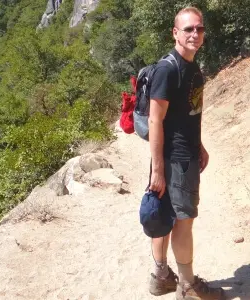
James Ian is a national park, camping and hiking expert.
He has dedicated his life to travel, visiting more than 80 countries, all 7 continents and most of the national parks in the United States. With over 35 years experience in the travel industry, James has worked on cruise ships, at resorts and hotels, and as a travel planner who’s helped hundreds of people plan successful trips to US national parks.
Based on his experience visiting our national parks multiple times, in-depth research and expertise as a travel planner, James has published detailed itineraries for many of the major national parks in the US. These itineraries, as well as in-depth park guides, and other resources will help you have your own incredible trip to US national parks without stress and hassle.
As a national park expert, James has contributed to many publications, including USA Today, Newsweek, Time Business News, Savoteur, Best Trip, and Wired.
I’m a member of the Amazon Services LLC Associates Program. As an Amazon Associate I earn from qualifying purchases.
